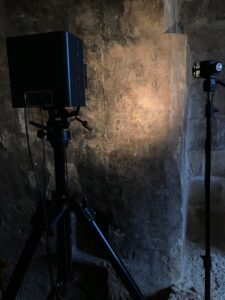The once common practice of marking buildings of significance provides all sorts of insights into the past
A unique gift given to Pope Francis by head of the Cyprus Institute Costas Papanicolas during his visit to the Vatican in May offers fascinating new perspectives on the importance and meaning of mediaeval graffiti.
The gift was an exact replica of a detail from the 14th century wall paintings in the catacomb of Saint Solomoni in Paphos, made possible by technical photography along with 2D and 3D imaging.
Local artists, archaeologists and art historians at the Andreas Pittas Art Characterisation Laboratories (APAC) of the Cyprus Institute used the traditional Byzantine technique of fresco painting to replicate the painting.
Even more importantly, digital images allowed for the precise reproduction of the original incised graffiti.
When people discover such incisions in churches and other public places nowadays, they often mistakenly believe these are due to vandalism, while mediaeval graffiti had a very different purpose, Mia Trentin, associate research scientist and leader of the APAC team told the Sunday Mail.
“The graffiti and their meaning is the real gift,” she said. “The understanding that writing or intervening on a historic monument is not tolerated in our times has falsely been applied to the past. Leaving a graffito, in general, but even more so on a religious space, aimed primarily to enforce someone’s presence in that specific place.”
The attitude towards cultural heritage changed in the 19th century, she pointed out. Following the preservation approach developed at the time, graffiti was from then on considered to deface surfaces.
“We now believe we should preserve heritage as it is and not make any changes, in the past it was more democratic, not that selective. Everybody could leave their mark on public monuments, and from what they recorded over time we can see which churches or saints were most popular for example. It was a means of interacting with places people deemed important.”
In addition, mediaeval graffiti shows the ability of the writers to use different communication and writing systems to express their messages, she said, as visitors have inscribed names, prayers, pictures and other information they thought was worth leaving at a place important to them – and such messages vary over time, telling us even more about the local history.
Moreover, the preliminary analysis of Cypriot graffiti highlights a heritage of daily practices which are still little explored, such as magic and superstition alongside religion, which are hard to come by via other historical evidence.
“The graffiti presence and distribution in Cyprus testifies to the spread of this practice among locals of the various communities and foreigners who visited or lived on the island, offering a lively and original perspective on past societies.”
Such messages left behind in places of worship were often part of a pilgrimage, Nikolas Bakirtzis, associate professor and director of the APAC labs added. “Monks and others in charge of churches allowed people to leave marks, they gave them access to frescos so they could record their name or other symbols. There are all kinds of messages, it is amazing!”
“Of course there are obvious acts of vandalism, like when parts of a fresco have been removed. But this is different from devotional graffiti. In the past it also had to do with superstition, for example when somebody took a little bit of [coloured] powder from the eye of a saint on a fresco. There was no intention to destroy anything.”
The new discoveries have great potential, Bakirtzis stressed.
“Historic graffiti provides new knowledge about the past and preserves hidden histories of monuments and sites. This is a flourishing field of research which is shedding new light on the history of the island and the economic and cultural routes of exchange in the Mediterranean.”
According to Trentin, the presence of graffiti in five different alphabets on the island, and the variety of shapes and motifs of pictorial graffiti reflect the multicultural character of the island.
Which is where the pope comes in, who, during his visit to Cyprus in December last year, spoke out in support of asylum seekers and migrants in the Mediterranean and talked about Cyprus as a place of pilgrimage.
Hence the gift, Bakirtzis explained.
“We chose a particular detail from the mediaeval fresco. An area where graffiti in Greek, Latin and Armenian underlines the multicultural allure of the particular cult site in Paphos – which traces its beginnings to the Early Christian period.”
In addition, this detail of the preserved fresco decoration bears evidence of the passage of pilgrims and migrants through the sacred underground site in the city of Paphos, linked with the Apostolic journey of Saint Paul and Saint Barnabas.
The associate professor sums up the importance of recent developments:
“The information contained in written and incised texts, drawings and shapes highlights the passage of everyday people, pilgrims and travellers from places of cult and worship. I think it is particularly important to be able to bring together advanced interdisciplinary research with artistic work towards the making of a replica which contains complex historical and cultural meanings.”








Click here to change your cookie preferences